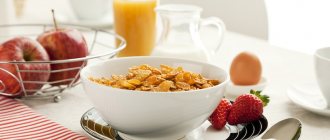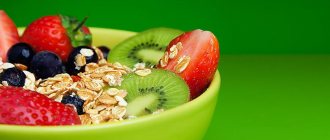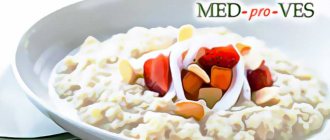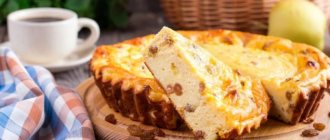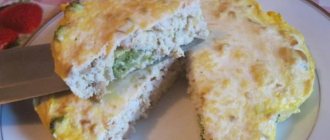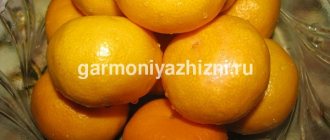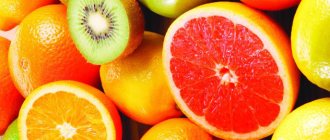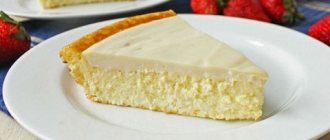Cottage cheese - 500 gr. Egg - 1 pc. Semolina - 2 tbsp. Butter - 20 gr. Sour cream - 20 gr. Salt - 5 gr. Granulated sugar - 30 gr. Add egg beaten with sugar, semolina, and salt to the pureed cottage cheese. Place the dough in a baking dish, brush with sour cream, and drizzle with melted butter. Bake in the oven at 180 degrees for 40 minutes.
In the article you will learn everything about the calorie content of cottage cheese casserole and which of its ingredients are effectively used in dietetics. We will share with you the secrets of preparing the most delicious casseroles, as well as several unusual recipes that you can easily implement.
Calorie content and consumption rate of this product
In addition to nostalgia for childhood, cottage cheese casserole can fill you up without adding extra weight. The calorie content of cottage cheese casserole per 100 grams of product is 160 kcal . Protein dominates this low-calorie dish. A casserole made from 1 kg of cottage cheese can provide the daily requirement of calcium for a family of 4, as well as most of the essential minerals for people who are lactose intolerant or do not like fermented milk products.
The dish is simple; you can find ingredients for the casserole in any store. This is also a good way to save money if the cottage cheese has been left in the refrigerator and has become harmful to the stomach: heat treatment will give it a second life and give you a pleasant experience. If you diversify the recipe, you can get both an appetizer and an elegant dessert.
The daily intake of cottage cheese for an adult is 250 g, for children under 9 years old – 100 g. For a child under 3 years old, it is better to make cottage cheese yourself. Let's see how many calories are in a regular cottage cheese casserole, and how many are in casseroles with different ingredients.
Calorie content of cottage cheese casserole in the oven per 100 grams
The calorie content of cottage cheese casserole cooked in the oven is 195 kcal per 100 grams. In 100 g of dish there are 14.1 g of protein, 10.4 g of fat, 11.5 g of carbohydrates.
For cooking you need the following products:
- 0.5 kg of cottage cheese;
- 2 tablespoons of semolina;
- 1 egg;
- 20 g butter;
- salt to taste;
- 30 g sugar.
- cottage cheese is mixed with egg, salt and semolina;
- the baking dish is greased with sour cream and sprinkled with 20 g of melted butter;
- The casserole is baked in the oven at 180° C for 35 - 45 minutes.
Calorie table depending on type
If you look at the calorie table for casseroles, you will see that the number of calories in cottage cheese casserole with semolina differs significantly from cottage cheese casserole with raisins. This will help us prepare casseroles correctly and at the same time not forget about the figure.
| Product | Calorie content (kcal) |
| calorie content of cottage cheese casserole without flour | 187 |
| calorie content of cottage cheese dietary casserole | 99 |
| from low-fat cottage cheese | 100 |
| from cottage cheese 5% | 153 |
| from cottage cheese 9% | 186 |
| calorie content of cottage cheese casserole, as in kindergarten | 231 |
| in a slow cooker | 178 |
| calorie content of cottage cheese casserole in the oven | 195 |
| calorie content of cottage cheese casserole with semolina | 179 |
| with semolina and sugar | 182 |
| with semolina without butter | 185 |
| calorie content of cottage cheese casserole with raisins | 202 |
| calorie content of cottage cheese casserole with semolina and raisins | 200 |
| with flour | 139 |
| with oatmeal | 218 |
| with apples | 136 |
| with banana | 162 |
| with dried apricots | 172 |
| with sour cream | 209 |
| with rice | 210 |
| with pasta | 228 |
Cottage cheese casserole, like in kindergarten
The casserole includes all the ingredients that the cooks added to this dish in kindergarten. It turns out sweet, tall and tender, and also very much reminds me of the taste of childhood.
Cooking time: 40 minutes.
Ingredients:
- Half a kilogram of cottage cheese.
- Sugar - three tbsp. l.
- Semolina - two tbsp. l.
- Butter - two tbsp. l.
- One egg
- Salt, vanillin.
- Raisin.
Cooking process:
Stage one: cottage cheese, butter. Mix cottage cheese with soft butter.
Stage two: eggs, sugar, cottage cheese, semolina, raisins, salt, vanillin. Add sugar to eggs and beat. Add eggs, raisins, semolina to cottage cheese and mix. Add salt and vanillin to taste and mix again.
Stage three: curd mass. Lightly rub a baking tray with oil and pour the cottage cheese into it. Bake for half an hour in an oven preheated to 180°.
Cottage cheese casserole, like in kindergarten, has a calorie content of 232 kcal per 100 g.
The basis of any casserole is cottage cheese. The remaining ingredients can be changed, so there are many recipes. You can add flour and semolina, you can prepare not a sweet, but a salty casserole with herbs and cheese. You can add different fruits and berries, such as pumpkin, cranberries, bananas and strawberries. You can change the fat content of the cottage cheese, add sour cream and kefir, but one thing will remain unchanged: the casserole is delicious. The main thing is to count calories and cook everything correctly.
Source https://www.davajpohudeem.com/pitanie_dlia_pohudeniya/kalorijnost_productov/gotovie_bluda/tvorozhnoj-zapekanki.html
Source
How it is used in dietetics and for weight loss
Cottage cheese casserole is an easily digestible dish for the digestive system, so it can be offered to children, the elderly and those on therapeutic diets. However, it is necessary to pay attention to the component casseroles.
What makes a casserole dietary is the absence of flour or semolina in it, then cottage cheese casserole becomes a gift for those who are losing weight, as it diversifies the diet and gives taste pleasure, while remaining a healthy dish. Many vitamins, calcium and protein strengthen bones and the entire body.
And if you add other healthy foods to the casserole, you can get an energy set of vitamins and microelements. For example, a casserole goes well with seasonal berries - raspberries, blueberries, strawberries, wild strawberries; with fruits - apples, bananas, any herbs and seasonings.
Casseroles are often used in the famous Dukan diet, in the Kremlin diet, in the protein diet . Low-fat, low-calorie cottage cheese (0%) is, oddly enough, not recommended for dieting, as well as for a healthy diet in general. For quality life, the body needs a little fat, so for weight loss it is better to take cottage cheese from 1.8% to 5% fat.
It is better to eat cottage cheese casserole in the first half of the day, as it takes longer to digest fermented milk products.
In dietary nutrition, unsweetened casserole can be eaten with tomatoes, cucumbers, sweet peppers, and herbs. Berries can add sweetness to the casserole.
Cottage cheese casserole "Chef's Tricks"
- Coarse-grained cottage cheese must be passed through a meat grinder or sieve to make your dessert tender.
- If the baking dish is metal, it must be degreased by sprinkling it with ground breadcrumbs.
- When cooking in the microwave, cover the dish with a lid. Baking time is from 5 to 8 minutes at maximum power. After cooking, let the dish rest for another 10 minutes in the oven.
- The average baking time is from 30 to 40 minutes, but if the curd mass turns out to be liquid, then it should be baked longer.
Cottage cheese casserole is a dish loved by many since childhood. As we get older, we never stop loving it, and having learned its benefits for our body, we try to prepare it for our children. Thanks to the main ingredient, the food is distinguished not only by its excellent taste, but also by a huge amount of useful substances.
Cottage cheese not only strengthens the skeletal system, but also promotes its rapid growth, which is very important for a growing child’s body, and for people of all ages. All thanks to the high calcium content in it. But in addition to this useful ingredient, cottage cheese also contains sulfur, potassium, phosphorus, iron, copper, zinc, magnesium and fluorine. In addition, it contains vitamin D, which perfectly helps in the absorption of calcium.
It contains organic acids, minerals and vitamins that are necessary for the human body. Daily consumption of this dairy product has a beneficial effect on the cardiovascular, nervous system, nails, and hair. It is allowed to be included in the diet even for those who suffer from gastrointestinal and digestive diseases, since it does not irritate the gastric mucosa and does not increase acidity
But the most interesting thing about this product is the substance - casein. It is this substance that helps you feel full for a long time. Don’t forget about beneficial bacteria, which help normalize not only digestion, but also intestinal microflora. It is no coincidence that it is recommended for people to eat after long-term use of antibiotics.
This product has practically no contraindications and is therefore considered harmless. The only exception may be individual intolerance to dairy products.
Many people do not like casserole, considering this dish to be very high in calories. Some believe that it should be cooked exclusively with semolina so that the calorie content is lower. But this is a mistaken opinion. In fact, the calorie content of flour and semolina is almost the same, although their benefits are different:
- flour - 342 kcal
- semolina - 328 kcal
If you want to reduce calorie content by using semolina, then it must be said that this will have almost no effect on the energy value of the dish. The only thing is that the taste of the casserole will depend on the composition. With semolina it turns out more tender and airy. And since both of these products are made from wheat, their nutritional value will be almost the same.
The dish can be a tasty and satisfying breakfast or light dinner. Of course, it will be interesting to know how many calories it contains. The food is classified as a dietary product because its energy value is not too high.
The average calorie content is 186-240 kcal per 100 g, depending on the fat content of the cottage cheese:
- Calorie content - 168-240 kcal;
- Proteins - 17.58 g;
- Fats - 4.1 g;
- Carbohydrates - 14.23 g.
How to reduce calories
To make this favorite dish more healthy and dietary, you just need to add the right foods to its composition, for example, carrots. Grated on a fine grater and squeezed, it will not bring excess moisture, but will add benefits. In addition, then the casserole will turn out to be a very beautiful golden-orange color.
You can use pumpkin instead of carrots. Moreover, both of these vegetables are very sweet, which means less sugar can be used in the recipe.
Those who don’t want to bother with vegetables can add fresh or frozen fruits or berries: apples, cherries, black or red currants, blueberries, raspberries or blackberries. Sugar can be replaced with mashed banana, it will be much tastier and healthier.
Those who are watching their figure and want to significantly reduce the number of calories should prepare a dish from low-fat cottage cheese, without eggs. You can diversify the taste by adding dry or fresh fruits to the curd mass.
So even those who are on a diet can eat such a dish, but no more than 2-3 servings per day (300-400 g).
With raisins? This dish is extremely easy to prepare, and even easier to eat for breakfast or afternoon snack. Even the most picky children eat this dish with pleasure and ask for more. But for those who are losing weight or maintaining a slim waist with diets, how to calculate how many calories are in a cottage cheese casserole? As with other dishes, it all depends on the nutritional value of the ingredients. Choose the recipe you want and eat to your health!
Popular recipes for preparing this product
Let's look at some simple and delicious recipes for cottage cheese casserole. To begin with, it should be noted that children are not the biggest fans of cottage cheese, which they need, which means a casserole is always the way out. Casseroles with cottage cheese do not have to be sweet (with raisins, dried apricots, prunes, candied fruits, pumpkin or carrots); they can be neutral and slightly salty (with potatoes, cauliflower or broccoli, herbs, olives).
It is best to prepare casseroles from homemade cottage cheese, then it will be nourishing and fluffy in appearance. You can find low-fat homemade cottage cheese on the market so as not to add centimeters to your waist.
The principle of preparing any casserole is the same: prepare a mold, lightly grease it with oil, sprinkle with semolina or flour, mix the ingredients, lay out, bake. To get a beautiful crust, you can grease it with yolk or sour cream. Cottage cheese casserole can be eaten either hot or cooled.
There are several secrets to making cottage cheese casserole:
- If the cottage cheese is runny, so that the casserole does not turn out wet, it is better to put it in a colander and wait a little until the liquid drains. You can also do this through gauze.
- To ensure that the casserole is lump-free, you can grind the cottage cheese through a meat grinder or rub it through a sieve. This way the casserole will be homogeneous, tasty and fluffy.
- It is better to buy low-fat and dry cottage cheese for casseroles.
- If you have fatty cottage cheese lying around waiting in the wings, then do not add products that contain fat (sour cream, cream).
- For a dietary casserole, if you don’t want to use cottage cheese alone, you can add sweet pumpkin or apples, then you won’t need sugar.
- If you like a looser casserole, then do not overuse eggs. Ideally, 2 eggs should be used per 500 g of cottage cheese.
- You cannot put the mixture for a future casserole in a preheated oven; it is better to raise the temperature with the mixture inside.
Regular cottage cheese casserole
You will need:
| fat cottage cheese | 250 g |
| egg | 2 pcs. |
| semolina | 1 tbsp. l. |
| vanillin | 2 g |
| orange zest | 1 tbsp. l. |
| sugar | 1 tbsp. l |
| salt | on the tip of a knife |
| soda | 1 tsp. |
| raisin | 30 g |
| dried apricots | 20 g |
How to cook:
- Thoroughly grind or twist the cottage cheese with the egg, add sugar, salt, soda, zest, raisins and dried apricots to the mixture, mix.
- Place the mixture in a greased form.
- Bake at 180 degrees for 40 minutes until golden brown.
Calorie content per 100 g of product – 240 kcal.
The nutritional value:
- proteins – 8.4 g;
- fats – 6.7 g;
- carbohydrates – 38.6 g;
- fiber – 1.2 g;
- water – 31.7 g.
BJU
Cottage cheese casserole with pasta
You will need:
| pasta | 250 g |
| cottage cheese 9% fat | 400 g |
| sugar | 0.5 stack. |
| soda | 1 tsp. |
| salt | 0.5 tsp. |
| butter | 50 g |
| crackers | 25 g |
How to cook:
- Boil 200 g of pasta.
- Mix 400 g of cottage cheese, half a glass of sugar, 1 tsp. soda, a little salt.
- Separately beat 3 egg whites, combine with curd mass and pasta.
- Grease the mold, sprinkle with breadcrumbs, and lay out the mixture.
- Drizzle melted butter on top.
- Sprinkle with breadcrumbs.
- Bake for up to 40 minutes at 180 degrees.
Calorie content per 100 g of product is 230 kcal.
The nutritional value:
- proteins – 11.2 g;
- fats – 9.1 g;
- carbohydrates – 27.3 g;
- fiber – 0.8 g;
- water – 33.4 g.
BJU
Curd casserole-pie
You will need:
| cottage cheese | 600 g |
| flour | 200 g |
| egg | 4 things. |
| butter | 150 g |
| sugar | 10 tbsp. l. |
| pitted cherries | 200 g |
| milk chocolate | 40 g |
| semolina | 2 tbsp. l. |
| soda | 1 tsp. |
| vanillin | 2 g |
How to cook:
- Flour, egg yolk, 4 tbsp. l. Mix sugar, melted butter and soda.
- We make the dough and divide it into two parts, where one is 20 percent more, the second is less.
- Most of it is crushed into shape by hand.
- Form a ball from the smaller part and place it in the freezer.
- Let's make the filling. Using a mixer, mix cottage cheese, three yolks, 6 tbsp. l. sugar, semolina and vanillin.
- Beat 4 egg whites until foamy and carefully fold into the curd mixture.
- Place cherries on the dough.
- Top with three smaller pieces of dough from the freezer.
- Sprinkle with grated chocolate.
- Place in the oven for 40 minutes. at a temperature of 180 degrees.
Syrniki
Photo: Christian restaurant
Recipe by Christian Lorenzini, chef at Christian restaurant
2 servings
- 200 g cottage cheese 9%
- 15 g flour
- 1 yolk
- 5 g powdered sugar
- salt
- vanillin
- 10 g ghee
- 20 g jam
Step 1. In a deep bowl, mix cottage cheese, egg yolk, flour, powdered sugar, salt and vanillin until smooth.
Step 2. Form the resulting mass into round balls weighing approximately 50–60 g and shape into small cakes.
Step 3. Roll each cheesecake in flour, fry in melted butter on both sides until golden brown.
Step 4. Transfer the cheesecakes into a refractory form and place in the oven for 2-3 minutes, preheated to 180 degrees.
Step 5. Serve the finished cheesecakes with jam, sour cream or condensed milk.
Nutritional value and chemical composition
Calorie content 160 kcal.
The nutritional value:
Chemical composition:
- vitamin A;
- vitamin B1, B2, B4, B5, B6, B9, B12, H, PP;
- retinol;
- vitamin E;
- vitamin C;
- vitamin D;
- calcium;
- magnesium;
- silicon;
- potassium;
- sulfur;
- sodium;
- phosphorus;
- chlorine;
- aluminum;
- boron;
- iron;
- vanadium;
- cobalt;
- iodine;
- copper;
- nickel;
- molybdenum;
- manganese;
- selenium;
- tin;
- titanium;
- fluorine;
- chromium;
- zinc;
- starch;
- Sahara;
- cholesterol;
- sterols.
Vitamins and benefits of the product
Cottage cheese casserole retains all the beneficial properties of fresh cottage cheese. If for some reason a person does not eat meat, then the protein found in cottage cheese will successfully replace it. also easily digestible, so it will help those who are restoring the body after illness . Cottage cheese contains almost the entire group of vitamin B, which is necessary for the nervous system and cellular metabolism, to normalize the digestive system and blood sugar.
The casserole retains all the calcium found in fresh cottage cheese, therefore it is recommended for consumption by those for whom fresh cottage cheese can cause digestive problems. These are small children, old people, nursing mothers. Most products are combined with cottage cheese, which enhances its benefits. The casserole contains phosphorus, magnesium and potassium in a perfectly balanced form, which are necessary for the health of nails, hair, heart and blood vessels.
Cottage cheese casserole is useful for liver diseases; it contains methionine, an amino acid that improves the condition of liver cells.
Video
A recipe for cottage cheese casserole without flour and sugar, but with dried fruits - very tasty, healthy and dietary.
If you are accustomed to the usual cottage cheese casserole of our childhood and do not know any other taste, be sure to try to experiment. Cottage cheese casserole can be a second course, an appetizer, a dessert, and a clever way to feed your child a healthy protein dish. Any product can be combined with cottage cheese, so you can try it many times, and believe me, not a single option will disappoint you. We are waiting for your stories about the most unexpected combinations in cottage cheese casseroles, share with us and our readers, you are especially interested in dietary casseroles.
How to cook cottage cheese casserole: general tips
Regardless of the chosen recipe for cottage cheese casserole, it should turn out fluffy, dense and rosy. To create a culinary masterpiece you need to follow some rules:
- The basis of all casseroles is cottage cheese. The wrong choice of cottage cheese will ruin all your efforts. Its fat content should be as high as possible. By the way, the same postulate applies when choosing cottage cheese for baking pies: a low-fat product will give a rancid taste when mixing the components;
- If there is excess liquid in the cottage cheese, you need to get rid of it. Let the cottage cheese drain a little by placing it in a colander or squeezing it out with a gauze napkin;
- Most recipes for cottage cheese casserole indicate that the cottage cheese should be mashed with a fork until smooth. This method will not add fluffiness to the casserole. Use a mixer - save both time and effort. If you don’t have one, you can rub the cottage cheese through a sieve.
The benefits of cottage cheese casserole
Dietary cottage cheese casserole without flour is one of the healthiest. It is perfect for both children and people with digestive problems. This dish will become indispensable in the menu of a person suffering from hepatitis, since, in fact, it is a very light dietary dish. Low-calorie cottage cheese casserole is also good for those who adhere to the Kremlin diet.
One name - cottage cheese casserole takes us back to distant childhood; this is a dish that should definitely be returned to your diet.
Dietary cottage cheese casserole can serve as an independent dish or as a light dessert.
Diet casserole recipes:
All recipes are easy to prepare and do not require any special investment of time or money, or any culinary skills. The ingredients are simple: cottage cheese, eggs, kefir and raisins. All! In order to diversify the dish, some add prunes and dried apricots to it.
The calorie content of cottage cheese casserole is very low - only 90 Kcal per 100g.
As you know, dietary cottage cheese casserole plays an important role in the development of the child’s body. Cottage cheese is rich in calcium, protein and is one of the best foods in terms of its nutritional properties, and raisins are a storehouse of mineral salts, vitamins and organic acids. Therefore, this is an ideal recipe for small children under the age of even one year.
Curd casserole: benefits and harm
Cottage cheese should definitely be included in the menu of those losing weight and vegetarians. Firstly, because of the phenomenal calcium content, useful for strengthening bones and teeth, maintaining the beauty of skin, hair and nails. It is the only dairy product that contains the required amount of B vitamins, usually obtained by humans from meat. Cottage cheese contains plant fiber, which keeps you feeling full for a long time,
Cottage cheese dishes are easily absorbed by the body, rarely causing allergic reactions. But the risk of allergies still exists. If you have an individual intolerance to milk protein, buy gluten-free products in specialized stores so as not to harm your own health.
Options for preparing dietary cottage cheese casserole
Today, many recipes are used to prepare cottage cheese casseroles without flour. But the main ingredients are usually the same for everyone: cottage cheese, eggs. By the way, when preparing this dish, you can add to the dough not only fruits, which have become traditional for cottage cheese casserole, but also vegetables, primarily pumpkin.
To prepare a low-calorie cottage cheese casserole you will need:
- 2 eggs,
- 250 g cottage cheese,
- 2 tablespoons low-fat kefir,
- 2 teaspoons sugar (or to taste)
- a handful of raisins.
Beat the eggs, mix 250 g of cottage cheese with two tablespoons of kefir. Then combine the two masses into one and add sugar and raisins. You can also use apple, prunes or dried apricots.
Place the curd mixture into a greased pan and place in the oven for 30-40 minutes. This casserole can be very easily prepared in a double boiler. To do this, make sure that the kit includes a special bowl for rice, casseroles and other liquid products.
Cottage cheese casserole and cheesecakes for adherents of healthy nutrition
Deed by Freepik
There are few people who do not like such popular dishes as casserole and cottage cheese pancakes.
It is believed that these desserts are very beneficial for the body, so those who are on a diet often introduce them into their diet.
However, there are so many recipes, and not all of them are suitable for losing weight. In order for baked goods to be tasty and not deposit on the sides and thighs, you need to know its calorie content and prepare it correctly.
Here we figure out how casserole and cheesecakes fit into the concept of proper nutrition, and look for optimal recipes for cottage cheese dishes.
